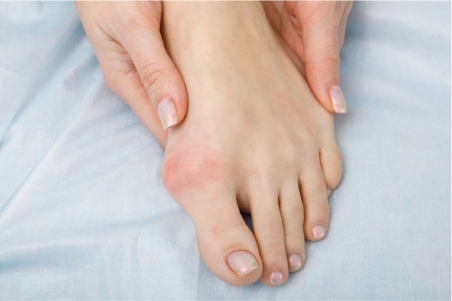
Bunions are one of the most common conditions I treat in my foot and ankle practice. While they can occur at any age, I see them most often in older adults and more frequently in women than men.
A bunion is easy to recognize. It looks like a bony bump at the base of the big toe joint. Typically a bunion develops over time due to pressure put on the feet and especially the toes. The big toe gradually leans toward the second toe, changing the angle of the underlying bone structure and creating the characteristic bump.
Bunions can run in families since some inherited foot types—such as flat feet and low arches–are more prone to developing bunions. People with certain types of arthritis or who have experienced foot injuries are also more likely to have this condition.
Symptoms usually appear as the deformity progresses, although some people never develop symptoms. Bunions may be sore or burn or become red and inflamed. Sometimes the big toe is numb or stiff and walking or even standing can be painful.
Wearing high heels or tight or pointed shoes can worsen symptoms and may explain why more women suffer from bunions. People who stand for long periods or work on their feet are also more likely to experience symptoms.
What can you do about bunions? There are several treatment options.
It’s important to wear shoes with a wide toe box and to avoid high heels or shoes that put pressure on the bunion. Cushioning the bunion with pads or taping can help minimize pain. In some cases, custom orthotics or inserts may be recommended by your physician.
To reduce the pain and swelling, a non-steroidal, anti-inflammatory drug such as ibuprofen may provide relief. Applying an ice pack several times a day can also help reduce inflammation and pain.
Occasionally, your physician may recommend steroid injections if the bursa, or fluid-filled sac around the joint, is inflamed. When possible, avoid activities that worsen the pain such as standing for too long.
If none of these treatments works and the pain interferes with your daily activities, a foot and ankle surgeon may discuss surgical options
with you.
For more information on bunions or to schedule a foot exam, contact Wentz Foot & Ankle Specialists at 719-539-6600.
Dr. Ralph Wentz is a board-certified foot and ankle surgeon in Salida and a fellow of the American College of Foot and Ankle Surgeons.
